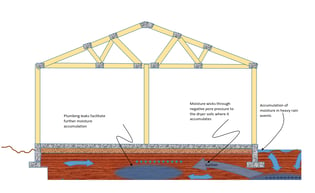In one of my recent posts, I discussed the various types of grouting with the applications for them, advantages and optimal uses each for each type of grouting for the various applications usually having to do with foundation repair and concrete leveling. For an overview see my previous blog. In this post I am going to discuss compaction grouting. Compaction grouting is one of the most useful types of pressure grouting. It is usually done to densify soil that usually is not able support infrastructure above it. If done properly is a very cost effective technique that builds columns of grout deep in the soil that not only densifies the soil but provides support through the columns.
Compaction Grouting, in order to be effective, needs to be done with Low Mobility Grout. This is a stiff cement and aggregate grout having a slump of 0-2 inches. This means if you deposit the grout in a standard slump cone and rod it with a dowel the required number of times and pull the cone up, it will slump 0 to 2 inches down. Many people erroneously feel that if you have a stiff enough mix that it is the only requirement. In order to be effective, the mix must have sufficient internal coefficient of friction to resist fracturing the soil and traveling. Toothpaste is zero slump, however it is too slippery and when it encounters weakness in soil would follow it fracturing the soil and traveling. This fracturing not only fails to densify the soil but results in actual weakening of the bearing capacity.
The ADSC has published a consensus guide using the best experts in the field backed by hundreds of field tests to identify the optimal gradation and mix to achieve a pump-able mix that still compacts the soil. The gradation curve is published and basically includes 10% pea gravel at the top end and 90% passing the 200 sieve, meaning that 10% is a silt or smaller particle.
Compaction grout since it is a low mobility grout has almost not chance of traveling to places where you don’t want it to such as electrical conduits, plumbing, soil weakness that goes near retaining walls or other structure that could be at risk of being damaged. There are lots of interesting stories of grout coming up in peoples toilets at in opportune times. These types of risks are drastically reduced if not eliminated with low mobility grout.
At the same time because the grout is low mobility, the chance of costs spiraling out of control is almost eliminated because the geometry is fairly defined and there is almost no chance of it traveling to a void area where it could rack up huge grout takes at the owner's expense.
Many contractors seem to think that any cement grout is equal to a compaction grout. This is simply not true. I have seen projects bid out as a compaction grout , only to see the contractor show up with a 1 ½” pipe to grout through. Although this pipe is easier to drive through hard soils it cannot pump the low mobility grout with out plugging up the grout delivery system with out either adding water or lubricants resulting in mobile grout that will travel and fracture soils.
Your inspecting engineer should understand these points and insist on the proper equipment to achieve low mobility grouting. If your inspecting engineer is leaving the details of the grouting process to the contractor’s discretion, then your engineer is not qualified to be inspecting.






